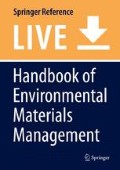Abstract
An appropriate techno-commercial framework is a prerequisite for sustainable sanitation solutions in urban centers. The first step toward developing such a framework is to have an assessment of provisioning sanitation systems in economic sense. The present study aims at estimating the per capita expenditure on sewerage system. The energy consumption and footprint are also important along with expenditure incurred and hence are also estimated separately. Results indicate that footprint for sewage treatment is approximately 0.1 m2 per person which is one tenth of the size of the toilet. The energy consumption in sewage pumping and treatment ranges from 0.03 to 0.1 KW-h (kilowatt-hour) which is equivalent to lighting 30 to 100 watt bulb for 1 h. The total per capita expenditure in availing sewerage infrastructure is estimated to be in the range INR (Indian Rupee Rates) 1.8–10.8 with an average of INR 3.93 and standard deviation 1.4. The higher values correspond to towns with very low population density, and the lower values correspond to very high population densities.
References
Bennis S, Bengassem J, Lamarre P (2003) Hydraulic performance index of a sewer network. J Hydraul Eng 129:504–510
Bartram J, Cairncross S (2010) Hygiene, sanitation, and water: forgotten foundations of health. PLoS Med 7(11):e1000367. https://doi.org/10.1371/journal.pmed.1000367
Bertrand-Krajewski JL, Lefebvre M, Lefai B, Audic J-M (1995) Flow and pollutt measurements in a combined sewer system to operate a wastewater treatment plant and its storage tank during storm events. Water Sci Technol 31(7):1–12
Census (2011) http://www.censusindia.gov.in/2011-prov-results/paper2-vol2/data_files/AP/Chapter_IV.pdf. Accessed July 2014.
CPCB (2009) Status of wastewater generation and treatment in class-I cities and class-II towns of India. Central Pollution Control Board, New Delhi
CPHEEO (2013) Manual on sewage and sewage treatment, part A: engineering. Central Public Health and Environmental Engineering Organization, (CPHEEO), New Delhi
DeFrancis MP (2011) Flagship report, Economic impacts of inadequate sanitation in India, Water and sanitation program. https://www.wsp.org/sites/wsp.org/files/publications/WSP-esi-india.pdf. Accessed 02 Oct 2017
Dodane PH, Mbaye Mbéguéré M, Sow O, Strande L (2012) Capital and operating costs of full-scale fecal sludge management and wastewater treatment systems in Dakar. Senegal Environ Sci Technol 46:3705–3711
Heijman SGJ, Guo H, Li S, van Dijk JC, Wessels LP (2009) Zero liquid discharge: heading for 99% recovery in nanofiltration and reverse osmosis. Desalination 236(1–3):357–362
IIT GRB (2010) Sewage treatment in class I towns: recommendations and guidelines. 003_GBP_IIT_EQP_S&R_02_Ver 1_2010
IIT GRB (2013) Draft interim report on Ganga river basin management plan, Consortium of 7 IITs
Luthra B (2013) Assessment and analysis of sanitation in India. M Tech thesis, Environmental Engineering and Management Programme, Department of Civil Engineering, Indian Institute of Technology, Kanpur
Luzio MD, Srinivasan R, Arnold JG (2003) A GIS-coupled hydrological model system for the watershed assessment of agricultural nonpoint and point sources of pollution. Trans GIS 8(1):113–136
Oren Y, Korngold E, Daltrophe N, Messalem R, Volkman Y, Aronov L, Weismann M, Bouriakov N, Glueckstern P, Gilrona J (2010) Pilot studies on high recovery BWRO-EDR for near zero liquid discharge approach. Desalination 261(3):321–330
RBI (2003) https://rbidocs.rbi.org.in/rdocs/content/pdfs/100MCA0711_5.pdf. Accessed Aug 2017
Semadeni-Davies A, Hernebring C, Svensson G, Gustafsson L-G (2008) The impacts of climate change and urbanisation on drainage in Helsingborg, Sweden: combined sewer system. J Hydrol 350(1–2):100–113
Tare V, Bose P (2009) Compendium of sewage treatment technologies, National River Conservation Directorate, Ministry of Environment and Forests, Government of India. http://nmcg.nic.in/writereaddata/fileupload/15_Technologies%20Involved.pdf. Accessed 30 Sept 2017
WHO (2004) http://www.who.int/water_sanitation_health/monitoring/jmp2004/en/. Accessed January 2017.
Author information
Authors and Affiliations
Corresponding author
Editor information
Editors and Affiliations
Section Editor information
Rights and permissions
Copyright information
© 2018 Springer International Publishing AG
About this entry
Cite this entry
Shukla, S., Tare, V. (2018). Assessment of Some Aspects of Provisioning Sewerage Systems: A Case Study of Urban Agglomerations in Ganga River Basin. In: Hussain, C. (eds) Handbook of Environmental Materials Management. Springer, Cham. https://doi.org/10.1007/978-3-319-58538-3_3-1
Download citation
DOI: https://doi.org/10.1007/978-3-319-58538-3_3-1
Received:
Accepted:
Published:
Publisher Name: Springer, Cham
Print ISBN: 978-3-319-58538-3
Online ISBN: 978-3-319-58538-3
eBook Packages: Springer Reference Chemistry and Mat. ScienceReference Module Physical and Materials ScienceReference Module Chemistry, Materials and Physics

